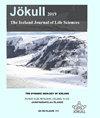IF 0.3
4区 地球科学
Q4 GEOSCIENCES, MULTIDISCIPLINARY
引用次数: 0
摘要
第一次有记录的访问Grímsvötn发生在1919年8月31日。两个瑞典地质学学生,哈肯·瓦德尔和埃里克·伊格伯格,站在一个迄今为止未知的大火山口的边缘。这一发现是8月27日从Síðujökull开始横跨Vatnajökull的第一个西向东样带中最重要的发现。这是一次对未知的探险,但主要目的仍然是在Skeiðarársandur上找到巨大的jökulhlaups的来源。他们将这个充满冰的火山口命名为“Svíagígur”。对20世纪30年代书面资料的研究表明,这个地方确实是Grímsvötn,在17世纪和18世纪很有名,但它的名字和位置在19世纪被遗忘了。从Svíagígur出发,他们继续向东走,沿着裂缝向下走Heinabergsjökull,于6日早晨到达文明地带。他们宣布,在Vatnajökull下面有一座巨大的火山,这就是从Skeiðarárjökull喷出的jökulhlaups的来源。当他们回到斯德哥尔摩时,他们受到了英雄般的欢迎,但很快就没人相信他们了,因为当时瑞典的知名人士坚持认为冰川下不可能有火山活动!完成学业后,两人都非常失望地离开了瑞典。哈肯·瓦德尔在美国的地质事业取得了成功,1932年他在芝加哥大学发表了博士论文。Erik Ygberg曾是一名国际勘探者,几年之后,由于Vatnajökull探险结束时经历的艰辛,他的健康状况不佳,迫使他回到瑞典,在瑞典地质调查局(Swedish Geological Survey)工作。虽然没有使用Svíagígur这个名字,但在Grímsfjall上标记最高点的两个双峰是为了纪念两位瑞典人Svíahúkur eystri和Svíahnúkur vestri而命名的。本文章由计算机程序翻译,如有差异,请以英文原文为准。
Grímsvötn 1919-2019: The legacy of Erik Ygberg and Hakon Wadell
The first recorded visit to Grímsvötn occurred on the 31st of August 1919. Two Swedish geology students, Hakon Wadell and Erik Ygberg, stood on the edge of a hitherto unknown large caldera. This discovery was the most significant finding in the first west-to-east transect across Vatnajökull, starting at Síðujökull on the 27th of August. This was an expedition into the unknown, but a principal aim was nevertheless to find the source of the large jökulhlaups on Skeiðarársandur. They named the ice-filled caldera “Svíagígur”. Studies of written sources in the 1930s revealed that this place was indeed Grímsvötn, well known in the 17th and 18th centuries but the name and location had been forgotten in the 19th century. From Svíagígur they continued eastwards, descending down the crevassed Heinabergsjökull, reaching civilization in the morning the 6th. They announced the news that a huge volcano existed under Vatnajökull and this was the source of the jökulhlaups emerging from Skeiðarárjökull. Upon their return to Stockholm, they received a hero’s welcome, but soon it all changed into no one believing them, as prominent figures in Sweden at this time insisted that a volcano can’t be active beneath a glacier! After they finished their studies, both left Sweden very disappointed. Hakon Wadell had a successful geological career in America presenting a doctoral thesis in 1932 from the University of Chicago. Erik Ygberg worked as an international prospector a few years before his bad health, a result of the hardships experienced at the end of the Vatnajökull expedition, forced him back to Sweden, where he had a career at the Swedish Geological Survey. The name Svíagígur has not been used but the two nunataks marking the highest points on Grímsfjall are named in the honour of the two Swedes, Svíahúkur eystri and Svíahnúkur vestri.
求助全文
通过发布文献求助,成功后即可免费获取论文全文。
去求助
来源期刊

Jokull
地学-地球科学综合
自引率
22.20%
发文量
1
审稿时长
1 months
期刊介绍:
Jökull publishes research papers, notes and review articles concerning all aspects of the Earth Sciences. The
journal is primarily aimed at being an international forum
for geoscience research in Iceland. Specific areas of coverage include glaciology, glacial geology, physical geography,
general geology, petrology, volcanology, geothermal research, geophysics, meteorology, hydrology and oceanography. Jökull also publishes research notes and reports from
glacier expeditions, book reviews, and material of interest to
the members of the Icelandic Glaciological and Geological
Societies
 求助内容:
求助内容: 应助结果提醒方式:
应助结果提醒方式:


